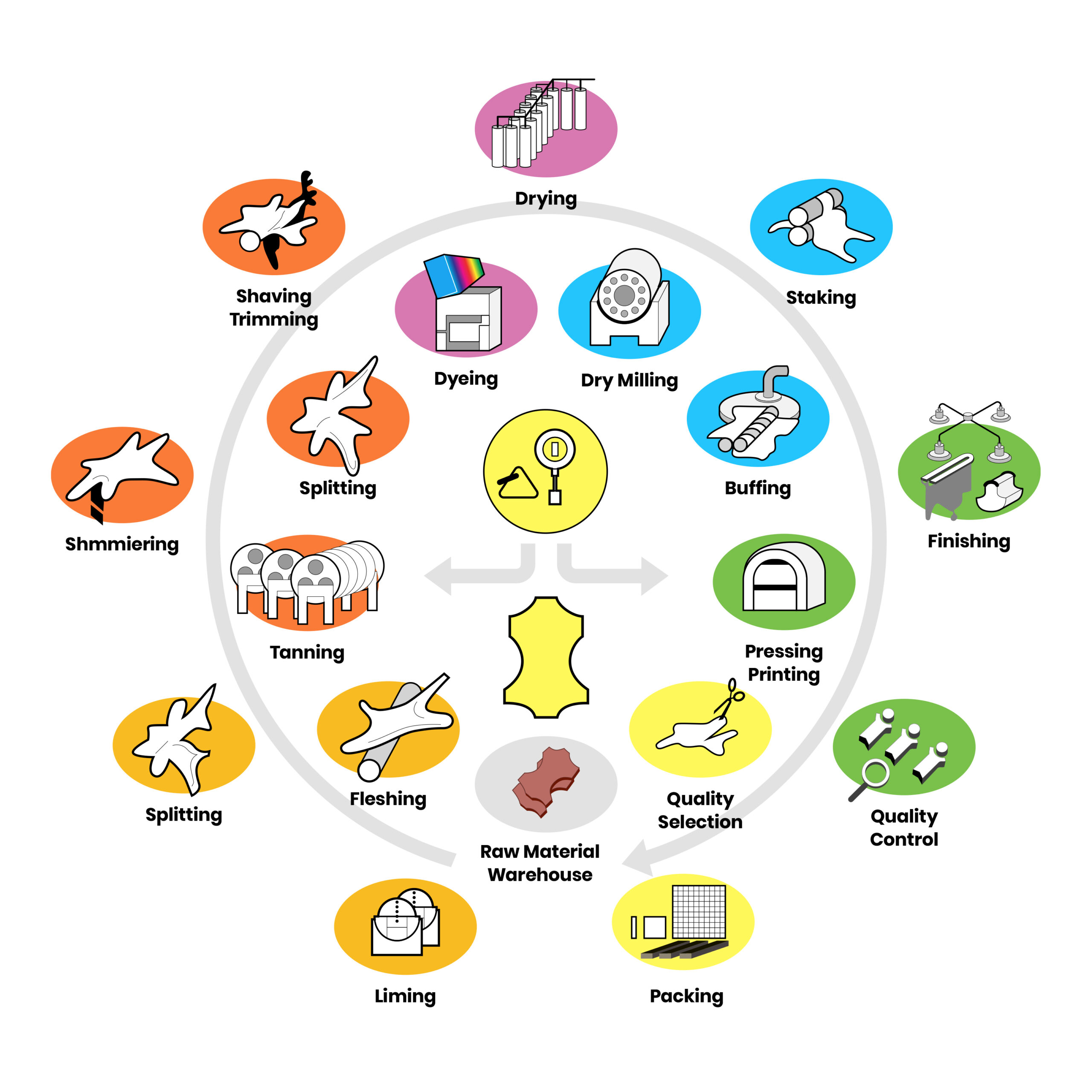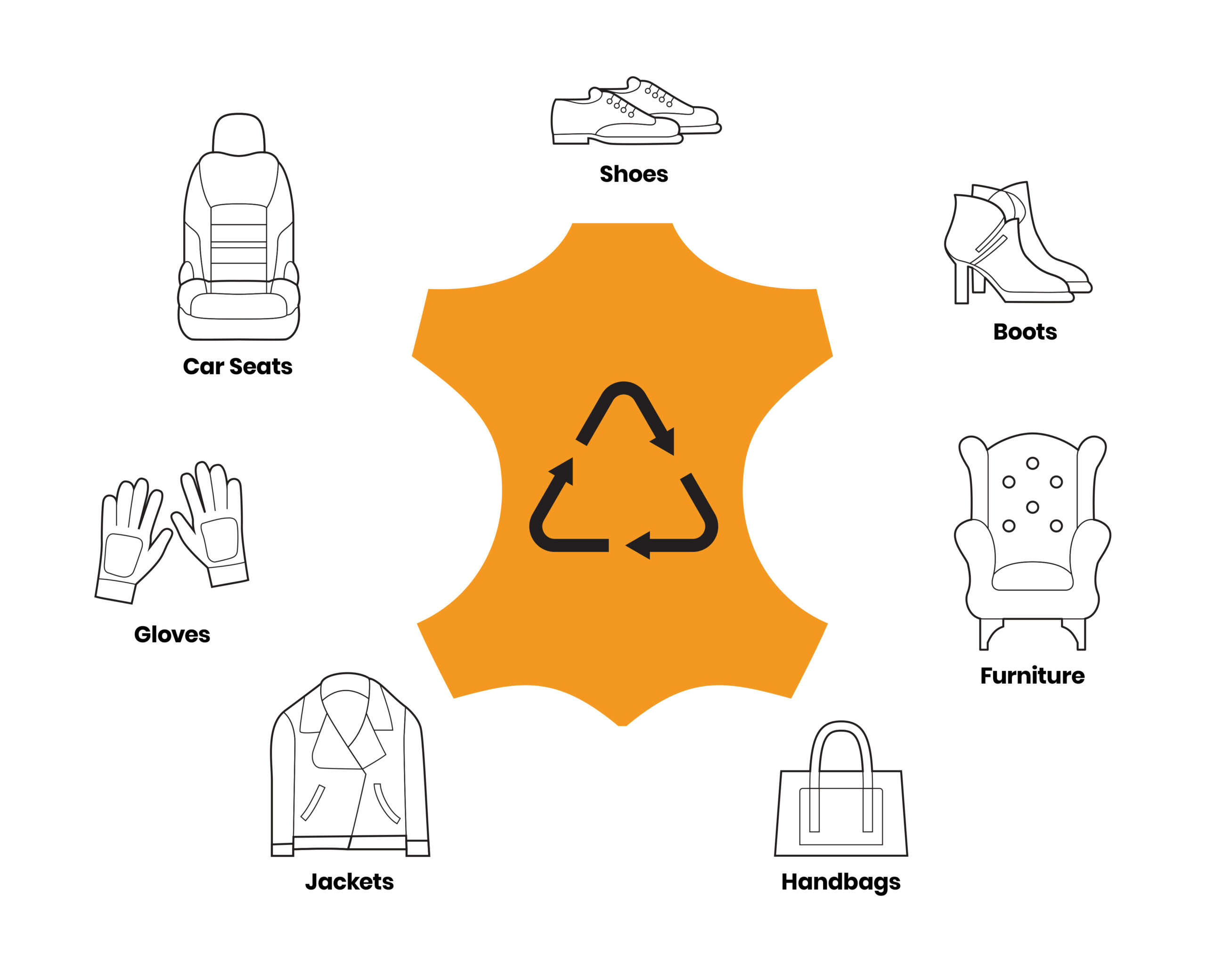How Leather is Made

Approximately 99% of the hides and skins used for leather are a by-product from the food industry. Turning this by-product into leather is the most responsible thing to do in a circular economy.
The five key processes of leather-making
There are many different types of leather and therefore many variants on the manufacturing process but in the main it can be broken down into these key operations.
- Cleaning
- Tanning
- Re-tanning
- Milling
- Finishing
The most confusing term used within the leather industry is the term ‘top grain.’ Ironically, ‘top grain’ is the definition generally used when the grain is not genuine; when in fact the real grain has been taken away and an imitation grain has been embossed into the leather. When the genuine grain remains, the leather is call ‘Full Grain’ or ‘Full Top Grain.’
The better quality of a hide or skin, the less it has to be treated. In a premium quality hide, the full natural grain is retained and exposed. One should see the “fat wrinkles” and natural markings, and the feel or hand should be supple and natural to the touch.
Although calfskins are finer than the hides of older animals, they are equal in durability and abrasion resistance because the fiber structure of the calfskin is denser, tighter and stronger than that of a cowhide. While some disparity of opinion exists over the relative quality of European hides vs. American hides, everyone generally agrees that hides in descending order of quality are: calfskin, premium cowhide, premium suede, select cowhide and production run cowhide.
Transforming hides into leather is done in three basic phases: pre tanning, tanning and finishing. Whatever is done to a piece of leather after it is tanned is part of the finishing process. This may include: dyeing, rolling, pressing, spraying, plasticizing, lacquering, antiquing, waxing, buffing, embossing, glazing, waterproofing, stain proofing, flame proofing or any other post-tanning treatment. Full-grain leathers are color-treated only by transparent aniline vegetable dyes which shade or color the skins without concealing or obscuring natural markings or grain character. Most furniture leathers have been treated with a costing of pigmentation to help even out the color or make the article more uniform and consistent.
Although many finish applications are administered for purposes other than altering or masking the surface of the leather, all applied opaque finishes and airtight surface sealants should be held suspect. Genuine, natural, unpigmented leather will breathe and ventilate, thus wicking away body heat. If upholstery leather is able to breathe, it can absorb moisture, be nourished, and remain soft and pliable. If the surface of the leather has pigmented or treated with many other finishes, as is the case for most automobile upholstery, the leather cannot breathe and may become stiffer.
The below diagram provides a general overview of the tanning lifecycle process. Please refer to the Glossary for details of each step.
Cleaning (Wet Processing)
The process of cleaning the hides & skins is known as the ‘beamhouse’. Any preserving salt, dirt, and flesh are removed together with the wool or hair and the hides degreased. In some case where the final leather will be ‘hair-on’ the hair or wool will be left intact.
Once the hides are clean they may be split to produce the top, grain layer, used to make full grain or nubuck leathers and a bottom layer used to make ‘split’ or suede leather. This allows the thickness of the leather to be adjusted for the final product. For example sturdy walking boots will require a thicker, firmer leather than soft trainers.
Skins are not split as they are already very fine and typically less than 1mm thick.
At this stage the hides and skins are still called pelts and as they have not been stabilised by the tanning process, have limited storage time.
Tanning
In the tanning process, the protein structure of the hides and skins are stabilised, making them durable, chemical resistant and less susceptible to decomposition, here the pelts are converted to leather.. Traditionally, the main tanning methods are based on chrome, vegetable tannins and chrome free alternatives.
If hides were not split in the beamhouse operation, they are usually split after tanning. Once tanning is completed leather tanned with chrome is known as ‘wet-blue’, leather tanned using chrome-free tannins is known as ‘wet-white’ and leather tanned using vegetable tannins, is called ‘vegetable or veg-leather’.
Re-tanning (Pre-finishing)
The re-tannage operation is what determines the final character of the leather and it includes dyeing to give colour and fat liquoring to add softness, fullness and touch. It is where the unique characteristics required for the end product will be determined- whether for automotive or aviation seating, footwear, garments or bags and leather goods. Once re-tannage is complete, the leather is known as ‘crust’.
Milling
Leather can be further softened after re-tannage by placing it in a dry tumble drum – this also enhances the natural grain structure and leathers softened in this way are often referred to as ‘tumbled’ and can be identified by their soft handle and naturally grainy appearance.
Finishing
Many surface finishes can be added – to give protection, create distinctive fashion effects or to enhance feel. These can be in the form of coats, dyes, waxes and oils and/or embossed or printed patterns. Once done, leather becomes ‘finished leather’.
Leather is currently the best way to up-cycle hides and skins from the meat industry; every year the leather industry converts around 7.3 million tons of hides that otherwise would go to landfill. Leather is so versatile that it is used in a range of products from soft gloves to comfortable footwear, and from long lasting furniture and automotive seating to contemporary clothing.

